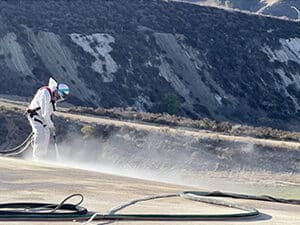California Water Regulators Collecting Data In Widening PFAS Investigation

The California State Water Resources Control Board has issued updated guidelines for local water agencies and is collecting data from more than 600 water system sites, two dozen airports and more than 200 landfills under a widening investigation into a class of widely-used chemicals known as per- and polyfluoroalkyl substances (PFAS).
PFAS are a component of firefighting foam used at airports, military bases and other locations where flammable fuels are present. According to the EPA, firefighting foams are one of the main sources of environmental PFAS contamination, leading to accumulation in soil and groundwater at sites of high usage. The man-made chemicals, which have come under increasing scrutiny in recent years, are highly toxic, even at extremely low concentrations, can move easily through ground water, and persist in both the environment and the human body.
PFAS include the widely studied perfluorooctanoic acid (PFOA) and perfluorooctanesulfonic acid (PFOS), among many other chemicals. Though they have largely been phased out of production in the U.S., PFAS, which have grease and stain-resistant properties, are still found in a wide variety of consumer products. These include food packaging, nonstick cookware, stain- and water-resistant fabrics, and cleaning products among many others. PFAS exposure can occur when using any of these products, eating food or drinking water contaminated with PFAS, or when working with PFAS-containing materials. Through use of these products and their disposal and degradation in landfills, PFAS chemicals make their way into soil and groundwater, and have the potential to contaminate drinking water sources. Widely studied forms of PFAS have been linked to hormonal effects, gestational development, increased cholesterol, and immune system effects in human studies.
States Respond to Threat Posed by PFASs
The testing orders were an early step in the state’s attempt to get a handle on a threat that has environmental and health groups calling for more aggressive action by the U.S.Environmental Protection Agency, which in 2016 issued a non-binding Health Advisory Level of 70 parts per trillion in drinking water for a combined concentration of two chemicals in the PFAS family. On July 31, California approved a state assembly bill requiring public water systems to monitor and publicly report both PFOA and PFOS in drinking water. And in August the State Water Resources Control Board announced that it was establishing new regulatory standards for the chemicals. The Board lowered the level at which local water agencies must report the presence of either PFOA or PFOS, from 14 parts per trillion to 5.1 parts per trillion and from 13 parts per trillion to 6.5 parts per trillion, respectively.
A number of states, including Michigan, Indiana, Wisconsin and Minnesota, have also called for a greater sense of urgency from the EPA.
California regulators plan to expand their testing to include samples from wells near manufacturing plants and military bases, where contamination has been found at 21 sites, including six bases where the chemicals pose a threat to the water supply of nearby neighborhoods, according a Los Angeles Times report.
Environmental Site Assessment for PFASs and Other Hazards
At Omega Environmental, we have decades of expertise in environmental assessment, consulting and remediation of hazardous materials in soil and ground water and in preparation for demolition, renovation and construction. Our work is trusted by contractors, architects and engineers on a wide variety of public and private projects, including airports, railways, educational facilities and historic properties.










